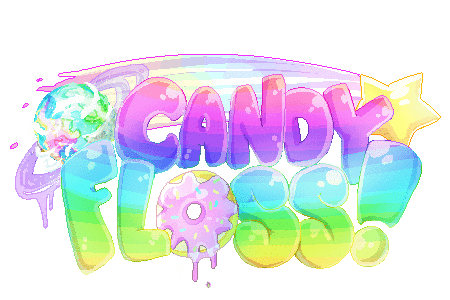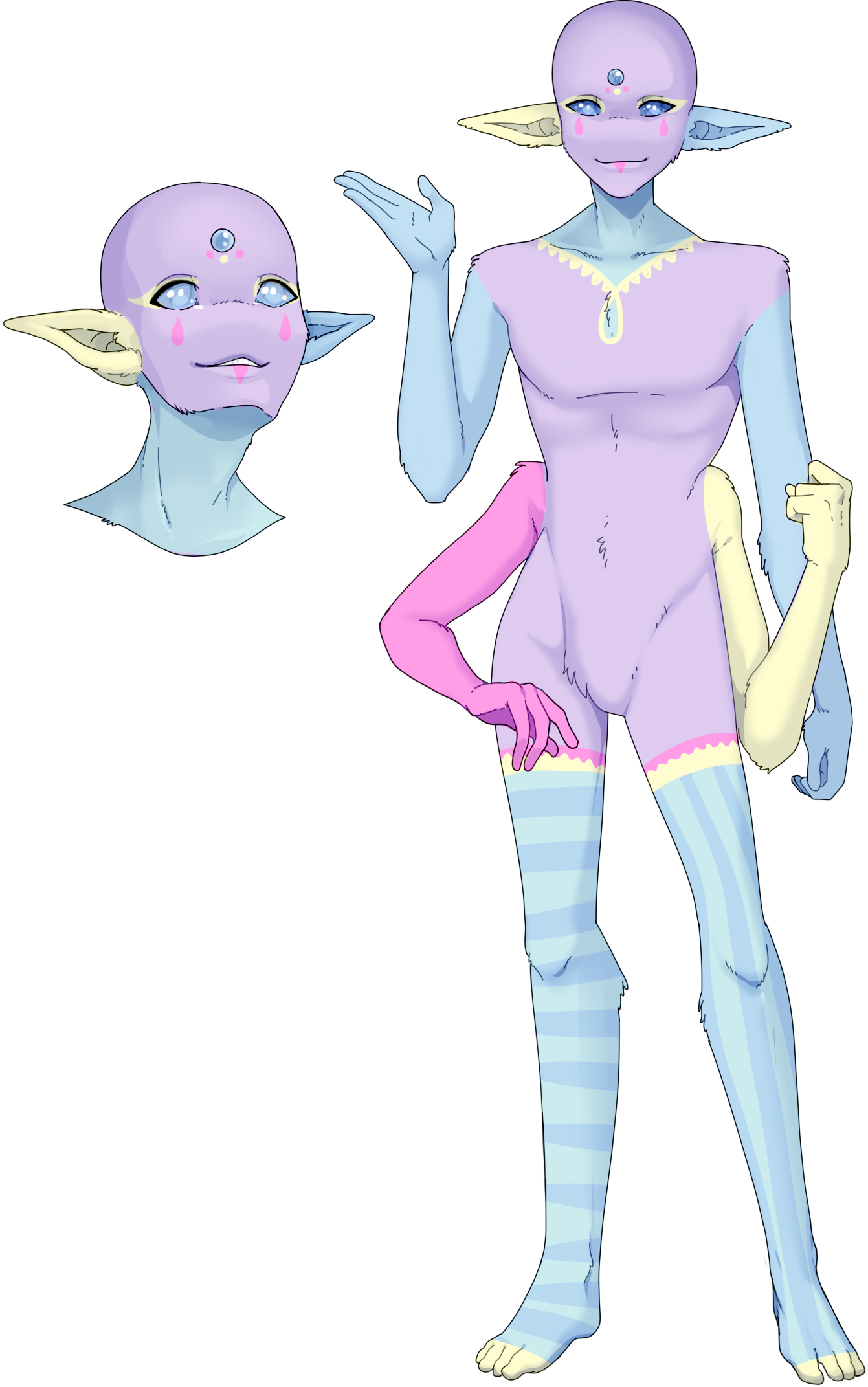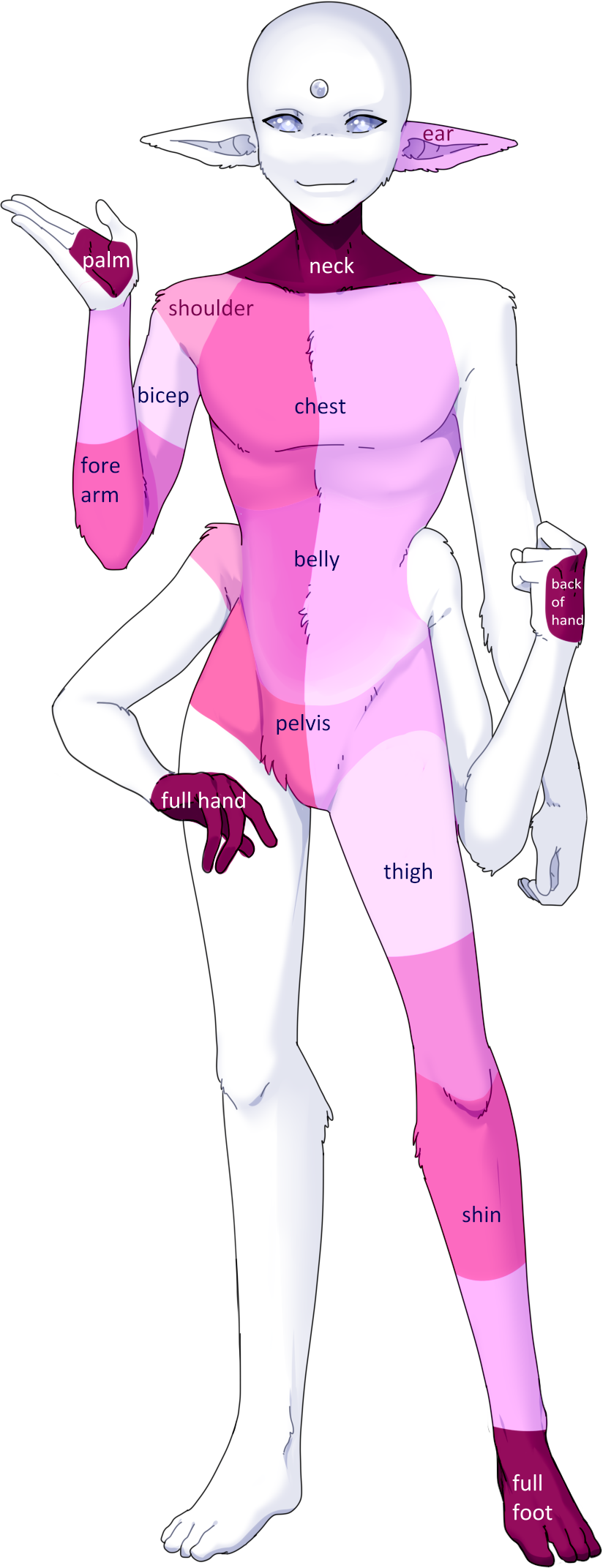coat types
Choose a coat type for your Candyfloss! A Candyfloss' coat of fur usually has markings or patterns on it, and it's one of their more unique features. These patterns can be natural and grown since they were born, or artificial but altering the follicles to grow a different color, similar to a tattoo on Humans. Natural markings can be passed down in families and are usually abstract, like whole areas being a different color, gradients, spots or stripes etc. but more specific markings like words, pictures, symbols and the like can be added artificially. The follicles can only be made to grow colors that are already in the Floss' color palette; except for Epsilon clan which has a special exclusive trait. These same principles can be applies to the skin or scales of Taffyfloss and Brittlefloss.Coat types are separated into different categories and rarities, and some flavors do not have access to all coat types. Read below about the different coat types and which flavors have access to which types.
common coat
Popfloss
Sugarfloss
Trufflefloss
Brittlefloss
Taffyfloss
Floss have this coat type be default unless it is upgraded or their flavor dictates otherwise.
requirements
The Candyfloss Common Coat is made up of a solid base color and simple gradients on specific locations on the body. These gradients can be made up of any palette color. The gradients on the body must have a soft blurred edge, as shown in the example. The gradients can be of two or more colors as long as the transition is smooth. Markings, smooth or otherwise are not allowed even if they are within the gradient area. The colors of each area do not have to match, and much be distinct enough from the base and each other to be easily noticeable.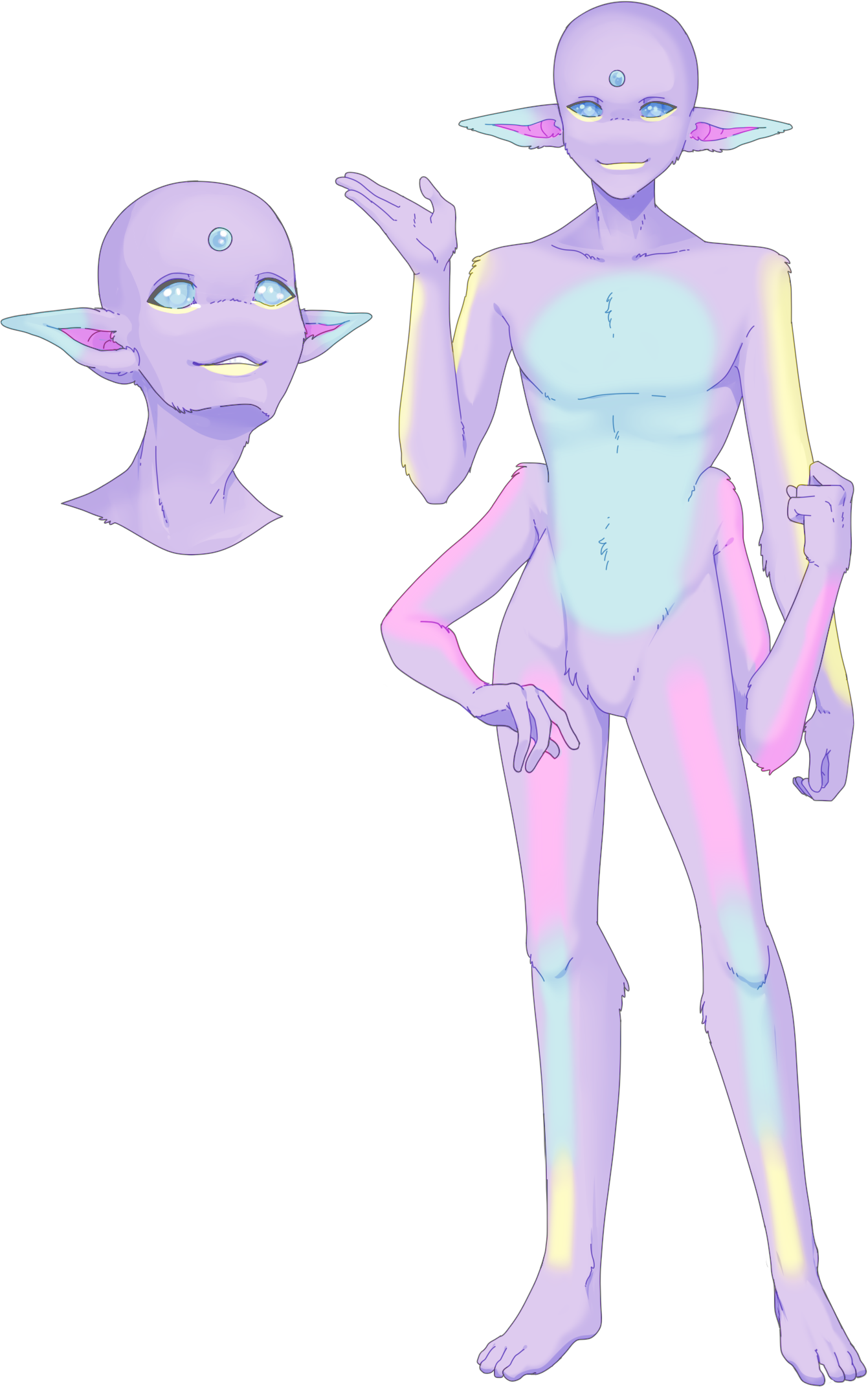
The areas that are required are as follows.
1. Belly; covering from just below the clavicle to just above the pelvic bones.
2. Arms; this is a straight line on the topside of all 4 arms from the shoulder to the wrist.
3. Legs; similar to the arms, a strait line from the top of the thigh to the ankle. The leg markings are omitted for Taffyfloss.
4. Ear tips; from the outer tip of both ears to about half way to the lobe.
5. Inner ear; the inner portion of the ear entirely.
6. Under eye; this is a straight line that can be blurred or sharp, from the inner tip to the outer tip of the eye along the bottom edge.
7. Lower lip; this can also be blurred or sharp edged, just covering the lower lip area. The lower lip marking is exempt of Brittlefloss and does not apply to their spare mouths.
additive coat
Popfloss
Sugarfloss
Trufflefloss
Brittlefloss
Taffyfloss
requirements
The Additive Coat type simply takes the Common Coat and adds small details to it. This means all areas listed for a common coat must be present. Freckles, stripes, tattoes, and markings of all kinds can be added in and around the required areas so long as the common coat areas are still clearly visible. Be sure to check your common coat requirements before adding onto it. All markings must align with the floss' palette.Odd colors cannot be the base color of your floss, base color is determined by the color that covers over 50% of the face and body.
Remember to read and follow our tos in regards to certain images and words that are banned from appearing as markings on floss.
Remember to read and follow our tos in regards to certain images and words that are banned from appearing as markings on floss.
Overhaul coat
Popfloss
Sugarfloss
Trufflefloss
Brittlefloss
Taffyfloss
requirements
The Overhaul coat is free range. This does not require the common coat areas. Any coat pattern that does not have the requirements for common, and does bot qualify for Blank Coat is an overhaul coat. All markings must be within your floss' color palette.Odd colors cannot be the base color of your floss, base color is determined by the color that covers over 50% of the face and body.
Remember to read and follow our tos in regards to certain images and words that are banned from appearing as markings on floss.
Remember to read and follow our tos in regards to certain images and words that are banned from appearing as markings on floss.
blank coat
Popfloss
Sugarfloss
Trufflefloss
Peppermintfloss
Brittlefloss
Taffyfloss
requirements
The Blank coat requires an almost completely solid colored coat. This coat type is required for the Peppermintfloss Flavor, but can also be applied to most other floss. To qualify as a Blank coat you can only have markings in a number of certain areas. Each area will add to your total, and if you exceed the max amount you will have to remove areas. Even if there is blank space around your markings, it will still count as using the whole area. Please keep in mind warping on images with chibi proportions and be mindful of what areas you're covering.Remember to read and follow our tos in regards to certain images and words that are banned from appearing as markings on floss.
Use the buttons below to view each area type. Types can be mismatched so long as they don't exceed the max allowed area. 1 Blue = 2 Pink = 4 Green, so you can have 1 Pink and 2 Green for example.
Blue Areas
Blue areas cover the whole allowed surface, meaning you can only have 1 blue area. Blue areas include-
1. Half of the face; the "face" is a circular area from just above the gem, to the chin, and just outside the outer edge of both eyes. This does not include the ears or scalp. The half line can be drawn horizontally from the bottom of the eye line, vertically through the center of the gem and lip, diagonally from the upper corner of an eye to the corner of the lip on the opposite side, or as the center of the face, from halfway through the eyes to just above the gem and just below the mouth.
2. Chest, this spans from the clavicle to the end of the rib cage. this does not span to the back of the floss.
3. Belly, this is just below the rib cage to the start of the pelvis, this does not span to the back of the floss..
4. Pelvis. This is the area below the belly, ending at the top of the thighs, this does not span to the back of the floss.
5. 1 Thigh, from below the pelvis to halfway into the knee. This does wrap around.
6. 1 Shin, halfway through the knee to the ankle. This does wrap around.
7. 1 Bicep, this does not include the shoulder. From below the shoulder to halfway thru the elbow. This does wrap around.
8. 1 Forearm, from halfway thru the elbow to the wrist. This does wrap around.
9. Upper back, this is the area on the back of the floss that covers the upper shoulder blades and aligns with the 'chest' area.
10. Lower back, this is the area below the upper shoulder blades to the hip, that aligns with the 'belly' area.
11. Butt, this is the butt. it aligns with the pelvis area.
Blue areas cover the whole allowed surface, meaning you can only have 1 blue area. Blue areas include-
1. Half of the face; the "face" is a circular area from just above the gem, to the chin, and just outside the outer edge of both eyes. This does not include the ears or scalp. The half line can be drawn horizontally from the bottom of the eye line, vertically through the center of the gem and lip, diagonally from the upper corner of an eye to the corner of the lip on the opposite side, or as the center of the face, from halfway through the eyes to just above the gem and just below the mouth.

2. Chest, this spans from the clavicle to the end of the rib cage. this does not span to the back of the floss.
3. Belly, this is just below the rib cage to the start of the pelvis, this does not span to the back of the floss..
4. Pelvis. This is the area below the belly, ending at the top of the thighs, this does not span to the back of the floss.
5. 1 Thigh, from below the pelvis to halfway into the knee. This does wrap around.
6. 1 Shin, halfway through the knee to the ankle. This does wrap around.
7. 1 Bicep, this does not include the shoulder. From below the shoulder to halfway thru the elbow. This does wrap around.
8. 1 Forearm, from halfway thru the elbow to the wrist. This does wrap around.
9. Upper back, this is the area on the back of the floss that covers the upper shoulder blades and aligns with the 'chest' area.
10. Lower back, this is the area below the upper shoulder blades to the hip, that aligns with the 'belly' area.
11. Butt, this is the butt. it aligns with the pelvis area.
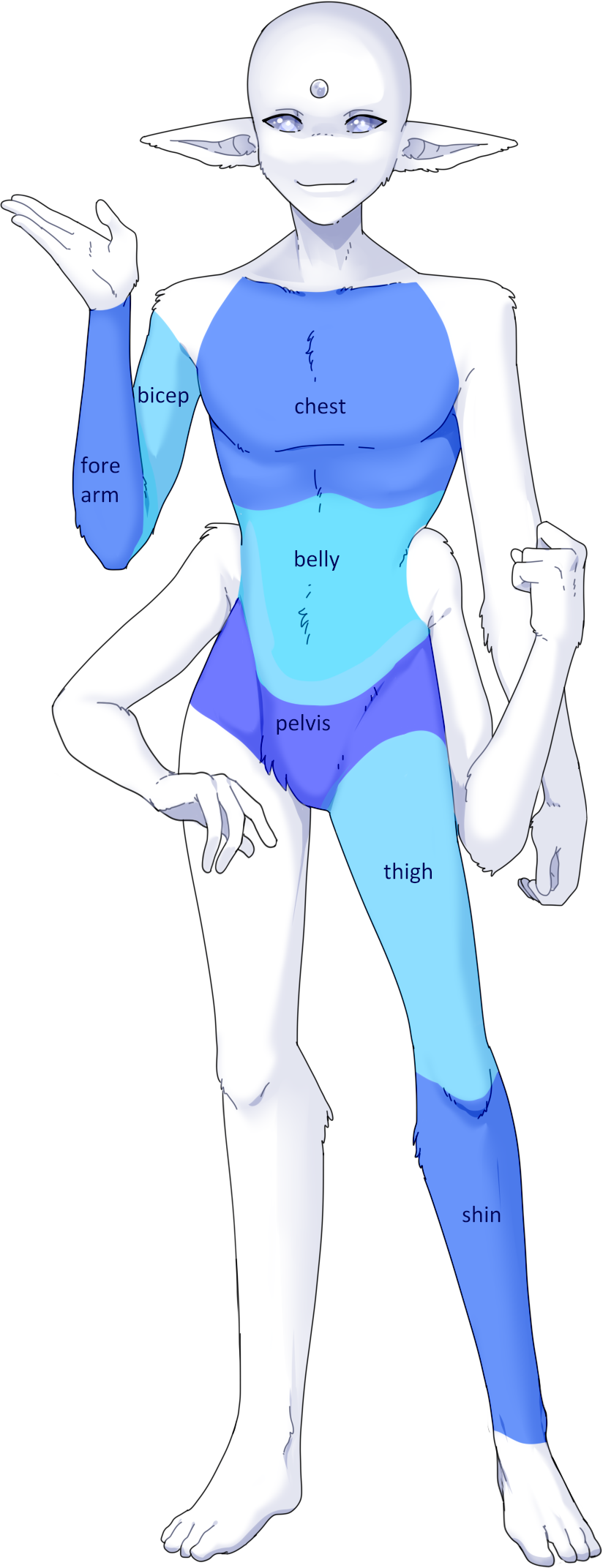
Pink Areas
Pink areas consist of half the allowed space, this means you can choose 2 Pink areas, or pair it with a set of greens.
Pink areas include -
1. One fourth of the face. Like in the blue zone, the "face" is a circular area from just above the gem, to the chin, and just outside the outer edge of both eyes. This does not include the ears or scalp. The 1/4th face are can be split vertically thru the center of the gem and lip, and the center of both eyes, horizontally at the bottom of the gem, at the bottom edge of the eyes and through the corners of the mouth, or split into quarters right ways, with a link through the bottom edge of the eyes and through the center of the gem and lip, or skewed from the corners of both lips, crossing to the upper edge of both eyes. 2. Both ears, includes both ears completely.
2. Both ears, includes both ears completely.
3. 2 Shoulders, the area between the upper arm and neck zones, or the same area on the lower set of arms.
4. 4 Palms, this does not include the fingers, and covers only the palm area on the inner side of all 4 hands.
5. 4 Backs of hands, similar to palm, allows all 4 back of the hands from wrist to knuckle.
6. 2 Hands, this includes the whole hand and fingers from wrist outward for 2 of the floss' 4 hands.
7. 2 feet. This is the whole foot from ankle outward for both of the floss' feet.
8. Neck, from the jaw of the floss to the clavicle. this wraps around.
The following areas are the same surface as their equivalents on the blue chart but are cut into half vertically down the center, horizontally in the middle, diagonally from the top corner to the opposite bottom corner, or in the middle to include half the space.
8. Half chest
9. Half belly
10. Half Pelvis
11. Half butt
12. Half upper back
13 Half lower back
14. Half bicep
15. Half forearm
16. Half Thigh
17. Half shin
Pink areas consist of half the allowed space, this means you can choose 2 Pink areas, or pair it with a set of greens.
Pink areas include -
1. One fourth of the face. Like in the blue zone, the "face" is a circular area from just above the gem, to the chin, and just outside the outer edge of both eyes. This does not include the ears or scalp. The 1/4th face are can be split vertically thru the center of the gem and lip, and the center of both eyes, horizontally at the bottom of the gem, at the bottom edge of the eyes and through the corners of the mouth, or split into quarters right ways, with a link through the bottom edge of the eyes and through the center of the gem and lip, or skewed from the corners of both lips, crossing to the upper edge of both eyes.
 2. Both ears, includes both ears completely.
2. Both ears, includes both ears completely. 3. 2 Shoulders, the area between the upper arm and neck zones, or the same area on the lower set of arms.
4. 4 Palms, this does not include the fingers, and covers only the palm area on the inner side of all 4 hands.
5. 4 Backs of hands, similar to palm, allows all 4 back of the hands from wrist to knuckle.
6. 2 Hands, this includes the whole hand and fingers from wrist outward for 2 of the floss' 4 hands.
7. 2 feet. This is the whole foot from ankle outward for both of the floss' feet.
8. Neck, from the jaw of the floss to the clavicle. this wraps around.
The following areas are the same surface as their equivalents on the blue chart but are cut into half vertically down the center, horizontally in the middle, diagonally from the top corner to the opposite bottom corner, or in the middle to include half the space.
8. Half chest
9. Half belly
10. Half Pelvis
11. Half butt
12. Half upper back
13 Half lower back
14. Half bicep
15. Half forearm
16. Half Thigh
17. Half shin
Green areas
Green areas are the smallest area and are 1/4 of your total allowed space, this means you can choose 4 green areas or pair 2 greens with 1 pink area. Green areas include -
1. Lips, the area on both the top and bottom lip. This does not apply to Brittle extra mouths.
2. Eyelids, both eye lids and the are just below the eyes. This is a very small space. This does not apply to Peppermint extra eyes.
3. Around the gem, a small surface just around the gem. This only counts for soul gems. 4. Inner ears, both inner ears.
4. Inner ears, both inner ears.
5. 1 Full ear
6. 1 shoulder
7. 2 Palms
8. Two backs of hands
9. 1 full hand
10. 1 full foot
11. Fingers on two hands, from knuckle onward. Includes thumb.
12. Toes, on both feet, from knuckle onward.
13. Wrists. just the wrist are where someone may wear a watch, on all 4 hands.
14. Ankles, similar to wrists but on both feet. Where an anklet would sit.
15. 1/2 of the Neck, this is the same neck section as in the pink zone but cut into the upper neck, the are a choker would sit on, and the clavicle area, from the base of the neck to the clavicle bone separately .
The following areas are the same surface as their equivalents on the blue and pink charts but are cut into 1/4th vertically down the center into 4 even sections, horizontally in the middle into 4 even sections, diagonally from the top corner to the opposite bottom corner in 4 sections, in a + pattern upright through the center or skewed into an X from the four corners.
16. 1/4th chest
17. 1/4th belly
18. 1/4th Pelvis
19. 1/4th butt
20. 1/4th upper back
21 1/4th lower back
22. 1/4th bicep
23. 1/4th forearm
24. 1/4th Thigh
25. 1/4th shin
Green areas are the smallest area and are 1/4 of your total allowed space, this means you can choose 4 green areas or pair 2 greens with 1 pink area. Green areas include -
1. Lips, the area on both the top and bottom lip. This does not apply to Brittle extra mouths.
2. Eyelids, both eye lids and the are just below the eyes. This is a very small space. This does not apply to Peppermint extra eyes.
3. Around the gem, a small surface just around the gem. This only counts for soul gems.
 4. Inner ears, both inner ears.
4. Inner ears, both inner ears. 5. 1 Full ear
6. 1 shoulder
7. 2 Palms
8. Two backs of hands
9. 1 full hand
10. 1 full foot
11. Fingers on two hands, from knuckle onward. Includes thumb.
12. Toes, on both feet, from knuckle onward.
13. Wrists. just the wrist are where someone may wear a watch, on all 4 hands.
14. Ankles, similar to wrists but on both feet. Where an anklet would sit.
15. 1/2 of the Neck, this is the same neck section as in the pink zone but cut into the upper neck, the are a choker would sit on, and the clavicle area, from the base of the neck to the clavicle bone separately .
The following areas are the same surface as their equivalents on the blue and pink charts but are cut into 1/4th vertically down the center into 4 even sections, horizontally in the middle into 4 even sections, diagonally from the top corner to the opposite bottom corner in 4 sections, in a + pattern upright through the center or skewed into an X from the four corners.
16. 1/4th chest
17. 1/4th belly
18. 1/4th Pelvis
19. 1/4th butt
20. 1/4th upper back
21 1/4th lower back
22. 1/4th bicep
23. 1/4th forearm
24. 1/4th Thigh
25. 1/4th shin
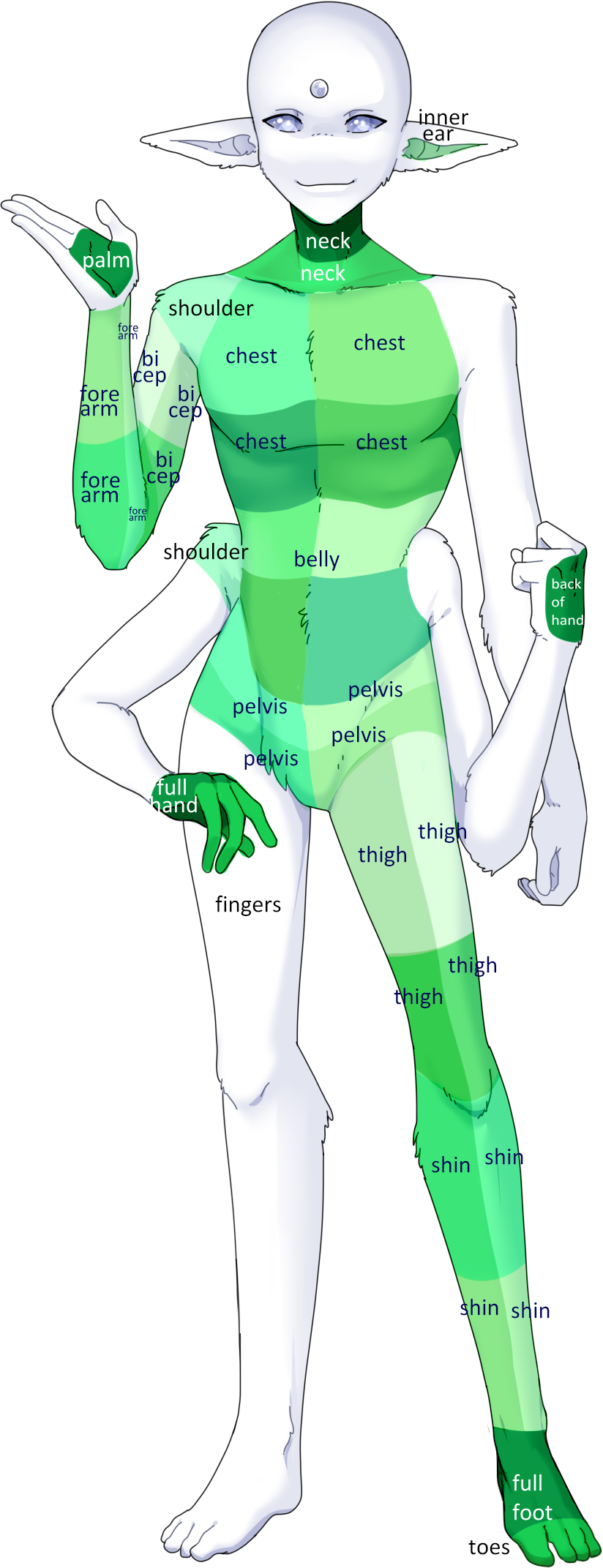
Looking for something else?
The Sourfloss have unique coat rules as a part of their Flavor, those rules can be found on the Sourfloss trait chart.
The Epsilon Henna trait is a clan exclusive trait and can be found in the Epsilon trait chart.
Taffyfloss' scale/leathered sections are not considered a coat type and can be found in the Taffyfloss trait chart.
The Sourfloss have unique coat rules as a part of their Flavor, those rules can be found on the Sourfloss trait chart.
The Epsilon Henna trait is a clan exclusive trait and can be found in the Epsilon trait chart.
Taffyfloss' scale/leathered sections are not considered a coat type and can be found in the Taffyfloss trait chart.
